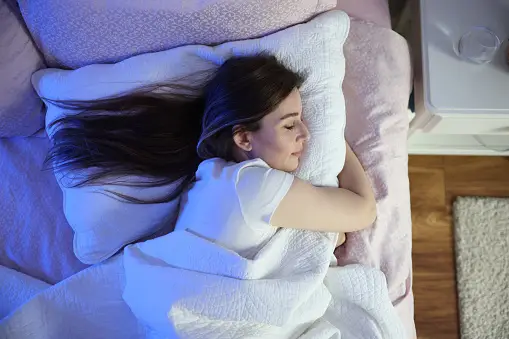Worldwide, more than 600 million people suffer from lower back pain discomfort, with difficulty sleeping frequently being the main complaint. Your body’s sleeping position can both cause and worsen back discomfort in addition to interfering with your sleep.
Thankfully, specialists have discovered some of the best techniques for arranging your body to help prevent back pain while you sleep.
Table of Contents
The Connection Between Pain in the Lower Back and Sleep

Empirical studies reveal intriguing connections between sleep disorders and back discomfort.
Having discomfort in the lower back, or any other kind for that matter, can make it challenging to settle down, go to sleep, and stay asleep. Furthermore, sleeping in a particular posture every night increases the likelihood that you will wake up with a backache. Finally, if your back pain prevents you from receiving the necessary amount of sleep, this can exacerbate your back pain by interfering with your sleep.
Many people may experience a vicious cycle of increased back pain and decreased sleep as a result of this complex interaction.
Positions of Sleep and Lower Back Pain

Even while it’s normal to wake up feeling stiff or with slight back discomfort, anything that occurs more often could have its roots, at least partially, in how you sleep.
While an improperly aligned sleeping position might exacerbate existing back discomfort or stiffness, a well-aligned sleeping posture can assist ease stress and tension on your spine.
Therefore, it’s crucial to keep your neck, midback, and lower back in their optimal spinal alignment while you sleep, just as you might strive for straight, aligned posture while standing.
Sleeping on one’s side may be the most comfortable option for individuals with back pain, while sleeping on one’s stomach may increase the likelihood of morning pain.
How to Achieve Pain Relief While Sleeping on Your Back?

Initially, it can seem that resting flat on your back is a smart method to maintain the appropriate alignment of your shoulders, back, and neck against the mattress.
Though some people may find it helpful, bear in mind that resting on your back might exacerbate lower back pain, particularly if gaps form between your body and the mattress due to the natural curvatures of your spine.
Therefore, if you prefer to sleep on your back, the doctors advise slightly elevating your knees with a pillow under them. This can further support the curvature of your spine to preserve alignment and ease any pressure on the lower back.
How to Reduce Back Pain While Sleeping on Your Side?

The majority of individuals sleep on their sides, which could be advantageous if you have lower back pain. This is because sleeping on your side can really assist maintain the balance and support of your spine, however those who have lower back problems may need to make a few adjustments.
Experts advise assuming a fetal position and putting a tiny pillow or rolled-up towel between the knees for side sleepers. The tiny gap between the legs not only helps prevent the knee joints from rubbing against one another, but it also relieves strain on the spine and permits your back muscles to fully relax and heal as you sleep.
How to Sleep on Your Stomach When You Have Lower Back Pain

According to sleep research, stomach sleepers are more likely to experience neck and back problems.
Your body sinks deeply into the mattress while you sleep facedown, which could cause your spine to arch incorrectly. Furthermore, having to turn your head to one side puts a significant strain on your neck and the rest of your spine.
For this reason, it’s usually recommended to try to avoid sleeping on your stomach if you have lower back pain, or at the very least, to use a thinner pillow to put your head on. If that sounds too difficult, remember that you can “train” yourself into sleeping in other positions, so try spending a night or two on your side or back to see if that helps ease your pain.
Some Advice for Improved Sleep

Experts advise trying a few other strategies in addition to changing your sleeping position to help ease the discomfort of back pain as you sleep.
Examine your mattress: Research indicates that changing an outdated mattress—one you’ve owned for ten or more years—can lessen back discomfort and enhance sleep quality. Researchers have shown that medium firm and adjustable mattresses may be the most effective in reducing pain and improving spinal alignment, especially for lower back discomfort. Since mattresses can be expensive, you may want to look into getting a mattress topper instead of a mattress to assist support your back.
Examine some new pillows: Getting a good night’s sleep depends on having pillows that are both supportive and comfy. They might also be very crucial for those who suffer from low back pain. The ideal supportive pillow for you will depend on your preferred sleeping position and body type, but consider which type is most comfortable for you to lay your head on and which is better for supporting your knees, for example, to ease pressure on your lower back.
Increase your movement: Exercise helps you sleep better overall and keeps your joints lubricated and healthy, which may reduce the likelihood that you will wake up with stiff or sore joints. Make sure you’re exercising for the required amount of time each week, which is often 30 minutes five days a week, but watch out that it doesn’t happen too close to bedtime as that can disrupt your sleep.1516 Before getting out of bed, do some light stretching exercises to assist relieve back pain and promote peaceful sleep.
When to Consult a Medical Professional

Though you might want to bring it up with your doctor during your next appointment, occasional or light back aches or pains in the morning are usually not a reason for concern.
However, it is advisable to consult a healthcare professional right away if you experience severe, persistent, frequent, or seemingly associated morning back pain. This is especially the case if the pain:
- Is abrupt or began following an accident
- Includes neurological problems such as tingling or numbness
- Does not seem to be improving
If another ailment is present (such as osteoarthritis or sciatica, for example), they will be able to assist in making a more definitive diagnosis and, if necessary, suggest a course of therapy.
An Overview
Lower back discomfort may be brought on by or made worse by your sleeping position. The consensus among experts is that sleeping on one’s stomach is the least beneficial position for someone with back pain, whereas sleeping on one’s side can improve spinal alignment and reduce back discomfort.
Not only may you change your sleeping position to relieve slight discomfort, but you can also try different mattresses, pillows, and light movement or stretching. An examination by a healthcare professional is necessary for any severe or persistent lower back discomfort.
